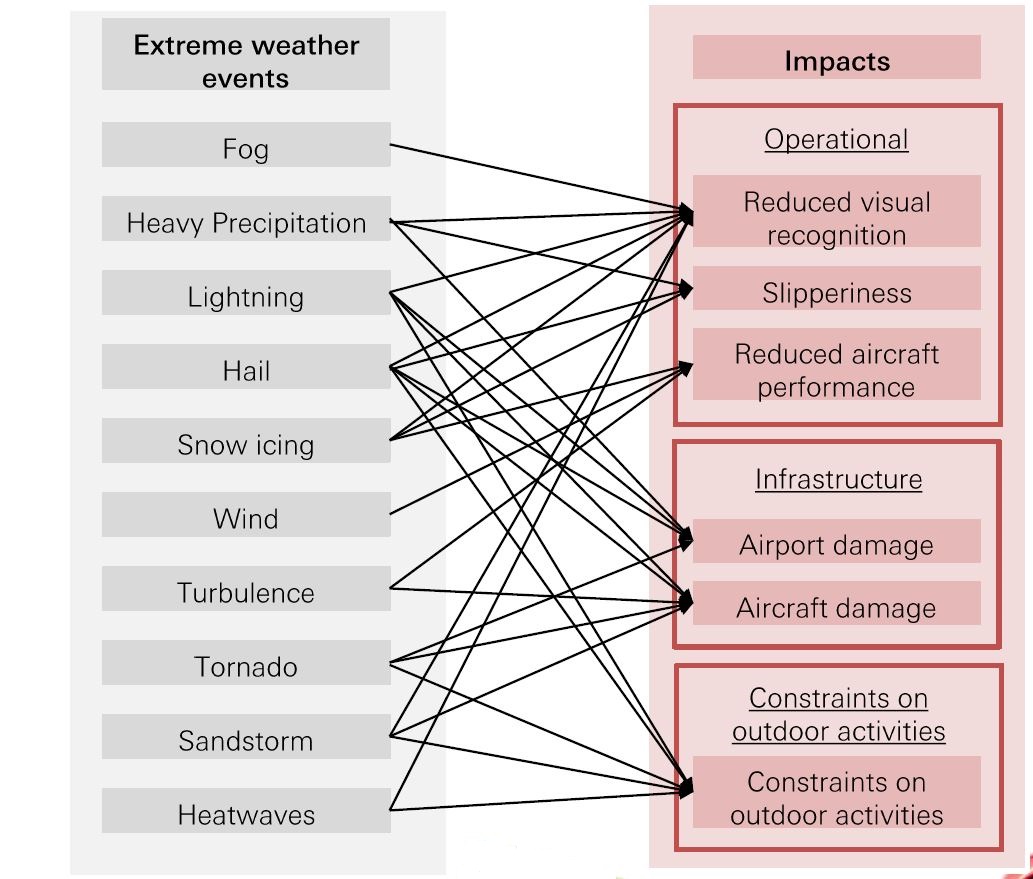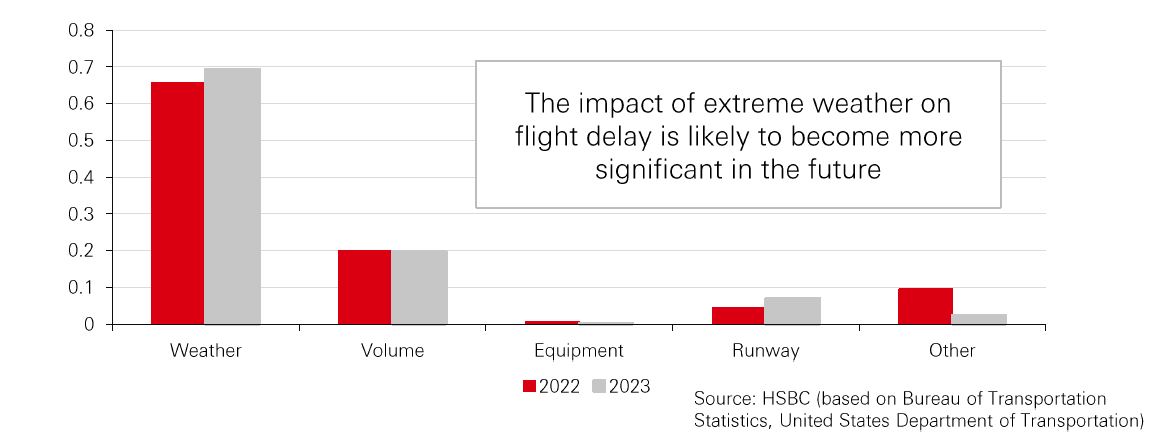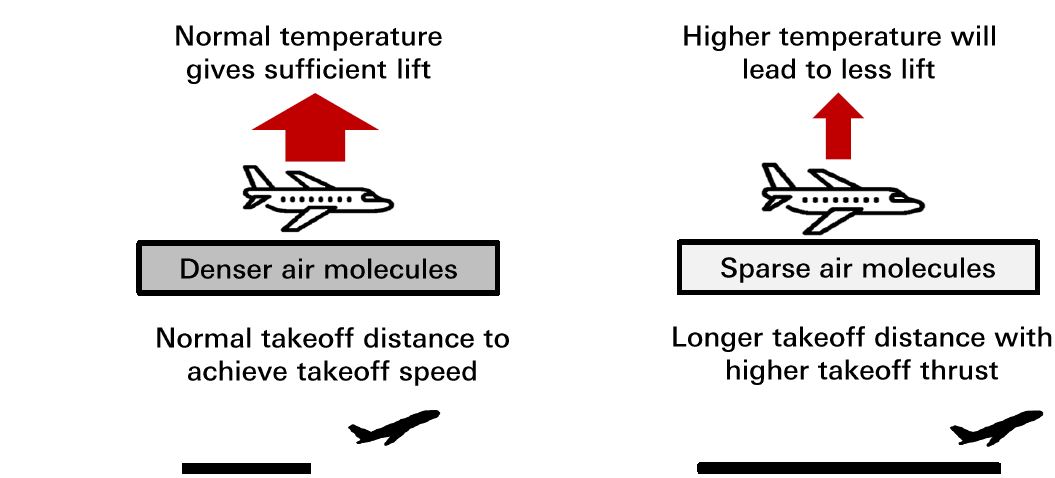
3 December 2024
Air travel is likely to be disrupted by the impact of climate change as more severe winter storms, hotter summer heatwaves and stronger jet streams impact flight operations. In this report, we discuss how aviation-related businesses, including airlines, airports and aircraft manufacturers, need to build resilience through investing in adaptation methods to reduce the incidence of flight delays and cancellations, and the resulting human and financial costs.
Source: What causes air turbulence and is the climate crisis making it worse?, Guardian, 21 May 2024, Johnson E. P., Aircraft deicer: Recycling can cut carbon emissions in half, January 2012, Flight Aware.
There has been much public discussion about how the aviation industry has intensified climate change, but relatively less that examines the impact of climate change on the aviation industry. For example, some extreme weather events have become more frequent and severe, which could lead to air travel disruptions. Aviation has been, and will need to be, more prepared for the potential changes brought about by climate change.
Impact of extreme weather on the aviation industry

Source: HSBC (based on Kreuz M. et al., Effect of restricted airspace on the ATM systems, July 2016)
Blizzards, winter storms, snow and reduced visibility are predicted to become more intense, despite shorter winters and rising temperatures[@why-esg-matters-06-01]. A recent example was the January 2024 Arctic blast that caused thousands of flight cancellations and more than 16,000 flight delays in the US. That said, we think extreme weather events are likely to cause more disruptions to air travel than continuous winter weather conditions in the future.
Carrier flight delays at departure by cause in the United States

Source: HSBC (based on Bureau of Transportation Statistics, United States Department of Transportation)
Climate change could also increase the incidence of icy conditions, as warmer air, holding more moisture, brings higher levels of rain and snow[@why-esg-matters-06-02]. Indeed, small amounts of frost and ice on a plane can interfere with takeoff, so we think airlines will need to strengthen their winter infrastructure, including de-icing equipment, workers with de-icing training and aircraft with efficient de-icing technology, to ensure smooth operations. However, these could lead to higher operating costs during the winter and an increase in the financial costs of flight delays.
Airports that aren’t usually affected by icing conditions would also need to be prepared for extreme weather events by upgrading their de-icing infrastructure. A disrupted polar vortex causes cold air to move south and brings unusually cold air to mid-latitudes, while a stable polar vortex would contain the cold air around the North Pole. With climate change likely to result in more frequent polar vortex disruptions[@why-esg-matters-06-03], airports would need to prepare for extreme winter conditions in mid-latitude areas, such as Texas and the Gulf Coast[@why-esg-matters-06-04].
Heatwaves can also impact flight operations, including the lift an aircraft can generate. Air expands when it heats up, meaning its density becomes lower, affecting lift. In general, every lift reduces by 1% for every 3°C increase in temperature. Planes, therefore, would need longer to reach speeds that can generate sufficient lift for takeoff. However, there are several ways to overcome this, including reducing the weight of the plane or extending the runway.
The impact of hot air on flying is, therefore, more significant at airports with short runways. We think airports that fall into this category might need to upgrade their infrastructure (i.e., longer runway distance) to cope with the increase in the number of days with extreme heat. However, some airports have no space to expand due to geographical constraints or dense neighbourhoods in the vicinity. These airports might be disrupted the most.
The impact of air temperature on aircraft lift and take-off

Source: HSBC
Aircraft manufacturers have been looking for ways to make planes lighter and more efficient during hot days. However, further gains are likely to require the invention of revolutionary new materials[@why-esg-matters-06-05]. Quite simply, the most effective way to avoid the heat is to take early morning and late-night flights, as these are less likely to be affected by the heat.
Another advantage of scheduling more flights during the cooler hours of the day is to avoid airport workers’ exposure to extreme heat. The temperature of taxiways and runways is usually much hotter than the atmosphere around the airport. Airport operators would need to be aware of protections and guidance provided for the workers during hot days.
Climate change will lead to faster jet stream winds, the strongest projected to speed up by about 2% for every 1°C of global warming[@why-esg-matters-06-06] and have multiple implications for flying.
Stronger jet streams can speed up flights when travelling in the same direction, as the planes get an additional push from the wind, which increases their relative ground speed. However, the four main jet streams only travel from west to east, so planes flying in the opposite direction are more likely to face stronger headwinds, causing more delays and in some extreme cases, additional or unexpected refuelling stops.
The risk of encountering clear-air turbulence (CAT) - turbulence with lower moisture content that is less detectable by conventional radar - also rises with stronger jet streams. Research shows that changes to the jet stream due to global warming will increase CAT by 113% over North America and as much as 181% over the North Atlantic by 2030 to 2050[@why-esg-matters-06-07], and that turbulence may cost US airlines as much as USD500m annually[@why-esg-matters-06-08].
Severe turbulence may cause substantial aircraft damage, and we think compensation claims from injured passengers, as well as associated maintenance and repair costs, could grow with more incidents. Advanced development of weather detection and prediction systems is important for pilots to better understand CAT and to enhance the safety and comfort of flying. This can also reduce fuel used to navigate around turbulent air, lowering operating costs.
The aviation industry is vulnerable to the increase in the intensity of extreme weather events, which could become increasingly costly. The industry needs to actively assess potential impacts and take relevant actions to adapt to climate change. In our view, investing in technological advancements in weather detection and forecasting, as well as upgrades to equipment and infrastructure, can help the industry adapt to some of the impacts of climate change in the longer term.




1. This report is dated as at 18 November 2024.
2. All market data included in this report are dated as at close 15 November 2024, unless a different date and/or a specific time of day is indicated in the report.
3. HSBC has procedures in place to identify and manage any potential conflicts of interest that arise in connection with its Research business. HSBC’s analysts and its other staff who are involved in the preparation and dissemination of Research operate and have a management reporting line independent of HSBC’s Investment Banking business. Information Barrier procedures are in place between the Investment Banking, Principal Trading, and Research businesses to ensure that any confidential and/or price sensitive information is handled in an appropriate manner.
4. You are not permitted to use, for reference, any data in this document for the purpose of (i) determining the interest payable, or other sums due, under loan agreements or under other financial contracts or instruments, (ii) determining the price at which a financial instrument may be bought or sold or traded or redeemed, or the value of a financial instrument, and/or (iii) measuring the performance of a financial instrument.
This document or video is prepared by The Hongkong and Shanghai Banking Corporation Limited (‘HBAP’), 1 Queen’s Road Central, Hong Kong. HBAP is incorporated in Hong Kong and is part of the HSBC Group. This document or video is distributed and/or made available, HSBC Bank (China) Company Limited, HSBC Bank (Singapore) Limited, HSBC Bank Middle East Limited (UAE), HSBC UK Bank Plc, HSBC Bank Malaysia Berhad (198401015221 (127776-V))/HSBC Amanah Malaysia Berhad (20080100642 1 (807705-X)), HSBC Bank (Taiwan) Limited, HSBC Bank plc, Jersey Branch, HSBC Bank plc, Guernsey Branch, HSBC Bank plc in the Isle of Man, HSBC Continental Europe, Greece, The Hongkong and Shanghai Banking Corporation Limited, India (HSBC India), HSBC Bank (Vietnam) Limited, PT Bank HSBC Indonesia (HBID), HSBC Bank (Uruguay) S.A. (HSBC Uruguay is authorised and oversought by Banco Central del Uruguay), HBAP Sri Lanka Branch, The Hongkong and Shanghai Banking Corporation Limited – Philippine Branch, HSBC Investment and Insurance Brokerage, Philippines Inc, and HSBC FinTech Services (Shanghai) Company Limited and HSBC Mexico, S.A. Multiple Banking Institution HSBC Financial Group (collectively, the “Distributors”) to their respective clients. This document or video is for general circulation and information purposes only.
The contents of this document or video may not be reproduced or further distributed to any person or entity, whether in whole or in part, for any purpose. This document or video must not be distributed in any jurisdiction where its distribution is unlawful. All non-authorised reproduction or use of this document or video will be the responsibility of the user and may lead to legal proceedings. The material contained in this document or video is for general information purposes only and does not constitute investment research or advice or a recommendation to buy or sell investments. Some of the statements contained in this document or video may be considered forward looking statements which provide current expectations or forecasts of future events. Such forward looking statements are not guarantees of future performance or events and involve risks and uncertainties. Actual results may differ materially from those described in such forward-looking statements as a result of various factors. HBAP and the Distributors do not undertake any obligation to update the forward-looking statements contained herein, or to update the reasons why actual results could differ from those projected in the forward-looking statements. This document or video has no contractual value and is not by any means intended as a solicitation, nor a recommendation for the purchase or sale of any financial instrument in any jurisdiction in which such an offer is not lawful. The views and opinions expressed are based on the HSBC Global Investment Committee at the time of preparation and are subject to change at any time. These views may not necessarily indicate HSBC Asset Management‘s current portfolios’ composition. Individual portfolios managed by HSBC Asset Management primarily reflect individual clients’ objectives, risk preferences, time horizon, and market liquidity.
The value of investments and the income from them can go down as well as up and investors may not get back the amount originally invested. Past performance contained in this document or video is not a reliable indicator of future performance whilst any forecasts, projections and simulations contained herein should not be relied upon as an indication of future results. Where overseas investments are held the rate of currency exchange may cause the value of such investments to go down as well as up. Investments in emerging markets are by their nature higher risk and potentially more volatile than those inherent in some established markets. Economies in emerging markets generally are heavily dependent upon international trade and, accordingly, have been and may continue to be affected adversely by trade barriers, exchange controls, managed adjustments in relative currency values and other protectionist measures imposed or negotiated by the countries with which they trade. These economies also have been and may continue to be affected adversely by economic conditions in the countries in which they trade. Investments are subject to market risks, read all investment related documents carefully.
This document or video provides a high-level overview of the recent economic environment and has been prepared for information purposes only. The views presented are those of HBAP and are based on HBAP’s global views and may not necessarily align with the Distributors’ local views. It has not been prepared in accordance with legal requirements designed to promote the independence of investment research and is not subject to any prohibition on dealing ahead of its dissemination. It is not intended to provide and should not be relied on for accounting, legal or tax advice. Before you make any investment decision, you may wish to consult an independent financial adviser. In the event that you choose not to seek advice from a financial adviser, you should carefully consider whether the investment product is suitable for you. You are advised to obtain appropriate professional advice where necessary.
The accuracy and/or completeness of any third-party information obtained from sources which we believe to be reliable might have not been independently verified, hence Customer must seek from several sources prior to making investment decision.
The following statement is only applicable to HSBC Mexico, S.A. Multiple Banking Institution HSBC Financial Group with regard to how the publication is distributed to its customers: This publication is distributed by Wealth Insights of HSBC México, and its objective is for informational purposes only and should not be interpreted as an offer or invitation to buy or sell any security related to financial instruments, investments or other financial product. This communication is not intended to contain an exhaustive description of the considerations that may be important in making a decision to make any change and/or modification to any product, and what is contained or reflected in this report does not constitute, and is not intended to constitute, nor should it be construed as advice, investment advice or a recommendation, offer or solicitation to buy or sell any service, product, security, merchandise, currency or any other asset.
Receiving parties should not consider this document as a substitute for their own judgment. The past performance of the securities or financial instruments mentioned herein is not necessarily indicative of future results. All information, as well as prices indicated, are subject to change without prior notice; Wealth Insights of HSBC Mexico is not obliged to update or keep it current or to give any notification in the event that the information presented here undergoes any update or change. The securities and investment products described herein may not be suitable for sale in all jurisdictions or may not be suitable for some categories of investors.
The information contained in this communication is derived from a variety of sources deemed reliable; however, its accuracy or completeness cannot be guaranteed. HSBC México will not be responsible for any loss or damage of any kind that may arise from transmission errors, inaccuracies, omissions, changes in market factors or conditions, or any other circumstance beyond the control of HSBC. Different HSBC legal entities may carry out distribution of Wealth Insights internationally in accordance with local regulatory requirements.
Important Information about the Hongkong and Shanghai Banking Corporation Limited, India (“HSBC India”)
HSBC India is a branch of The Hongkong and Shanghai Banking Corporation Limited. HSBC India is a distributor of mutual funds and referrer of investment products from third party entities registered and regulated in India. HSBC India does not distribute investment products to those persons who are either the citizens or residents of United States of America (USA), Canada, Australia or New Zealand or any other jurisdiction where such distribution would be contrary to law or regulation.
The following statement is only applicable to HSBC Bank (Taiwan) Limited with regard to how the publication is distributed to its customers: HSBC Bank (Taiwan) Limited (“the Bank”) shall fulfill the fiduciary duty act as a reasonable person once in exercising offering/conducting ordinary care in offering trust services/ business. However, the Bank disclaims any guarantee on the management or operation performance of the trust business.
The following statement is only applicable to PT Bank HSBC Indonesia (“HBID”): PT Bank HSBC Indonesia (“HBID”) is licensed and supervised by Indonesia Financial Services Authority (“OJK”). Customer must understand that historical performance does not guarantee future performance. Investment product that are offered in HBID is third party products, HBID is a selling agent for third party product such as Mutual Fund and Bonds. HBID and HSBC Group (HSBC Holdings Plc and its subsidiaries and associates company or any of its branches) does not guarantee the underlying investment, principal or return on customer investment. Investment in Mutual Funds and Bonds is not covered by the deposit insurance program of the Indonesian Deposit Insurance Corporation (LPS).
Important information on ESG and sustainable investing
In broad terms “ESG and sustainable investing” products include investment approaches or instruments which consider environmental, social, governance and/or other sustainability factors to varying degrees. Certain instruments we classify as sustainable may be in the process of changing to deliver sustainability outcomes. There is no guarantee that ESG and Sustainable investing products will produce returns similar to those which don’t consider these factors. ESG and Sustainable investing products may diverge from traditional market benchmarks. In addition, there is no standard definition of, or measurement criteria for, ESG and Sustainable investing or the impact of ESG and Sustainable investing products. ESG and Sustainable investing and related impact measurement criteria are (a) highly subjective and (b) may vary significantly across and within sectors.
HSBC may rely on measurement criteria devised and reported by third party providers or issuers. HSBC does not always conduct its own specific due diligence in relation to measurement criteria. There is no guarantee: (a) that the nature of the ESG / sustainability impact or measurement criteria of an investment will be aligned with any particular investor’s sustainability goals; or (b) that the stated level or target level of ESG / sustainability impact will be achieved. ESG and Sustainable investing is an evolving area and new regulations are being developed which will affect how investments can be categorised or labelled. An investment which is considered to fulfil sustainable criteria today may not meet those criteria at some point in the future.
THE CONTENTS OF THIS DOCUMENT OR VIDEO HAVE NOT BEEN REVIEWED BY ANY REGULATORY AUTHORITY IN HONG KONG OR ANY OTHER JURISDICTION. YOU ARE ADVISED TO EXERCISE CAUTION IN RELATION TO THE INVESTMENT AND THIS DOCUMENT OR VIDEO. IF YOU ARE IN DOUBT ABOUT ANY OF THE CONTENTS OF THIS DOCUMENT OR VIDEO, YOU SHOULD OBTAIN INDEPENDENT PROFESSIONAL ADVICE.
© Copyright 2025. The Hongkong and Shanghai Banking Corporation Limited, ALL RIGHTS RESERVED.
No part of this document or video may be reproduced, stored in a retrieval system, or transmitted, on any form or by any means, electronic, mechanical, photocopying, recording or otherwise, without the prior written permission of The Hongkong and Shanghai Banking Corporation Limited.